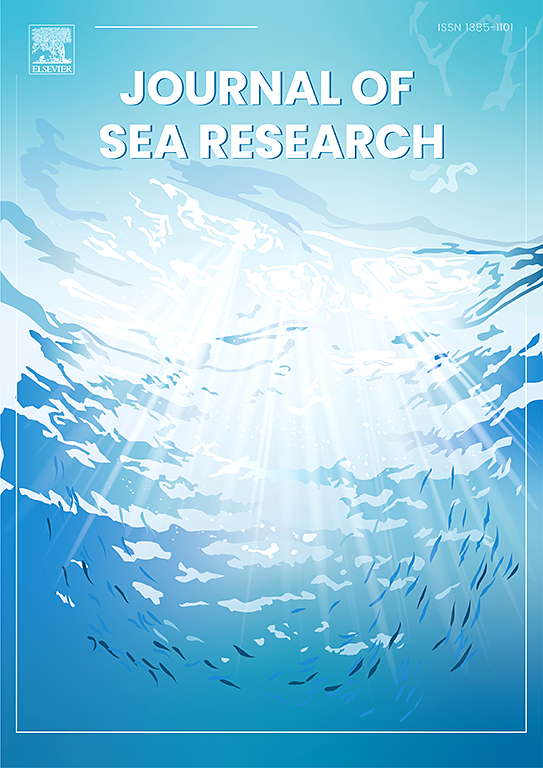探索神秘的远洋幼体牡蛎(珍珠贝)促进牡蛎渔业的河口恢复
IF 2.9
4区 地球科学
Q2 MARINE & FRESHWATER BIOLOGY
引用次数: 0
摘要
河口生态系统中牡蛎礁的急剧减少引起了人们对牡蛎恢复的极大关注;然而,到目前为止,大多数努力主要针对的是它们的底栖期,这使得远洋牡蛎幼虫基本上难以捉摸。本研究在2023年和2024年的牡蛎产卵季节(5 - 10月),对美国德克萨斯州加尔维斯顿湾(Galveston Bay, USA)亚热带河口的远洋牡蛎(Crassostrea virginica)幼虫的密度、分布和大小结构进行了研究,以评估环境条件对幼虫动态和招募的影响。在2024年5月和6月的极低盐度年份中,除热条件相对相似外,盐度和叶绿素a (Chl-a)差异显著。幼虫密度与地点和月份显著相关,2024年11个地点中有9个地点和6个月中有4个地点的幼虫密度低于2023年。中前期(5 ~ 8月)和后期(9 ~ 10月)产卵期幼虫的尺寸结构存在显著差异,大量的小尺寸个体(70 ~ 200 μm)逐渐向较少的大尺寸个体(250 μm)转移。生命阶段的细分显示,在两个产卵季节中,阶段1和阶段2的百分比较高,阶段5的百分比较低。盐度是影响幼虫密度的最主要环境因子,其次是与水温、水温和Chl-a的交互作用。地质统计共克里格分析显示,2023年上湾、东湾和西湾的幼虫密度相对较高,而2024年西岸线至西湾的幼虫密度较高。2023年,下湾的早期幼虫密度高于中湾和上湾,而下湾的后期幼虫数量较多。2024年北部近岸区早期幼虫密度较大,晚期幼虫相对丰富,西北和西南地区尤为明显。寻找早期和晚期浮游牡蛎幼虫密度较高的地区可能有助于确定幼虫的来源和汇。这些见解可以更好地为牡蛎保护区的战略布局提供信息,并提高这种经济和生态上重要的海洋生物资源的恢复和管理工作的有效性。本文章由计算机程序翻译,如有差异,请以英文原文为准。
Exploration of enigmatic pelagic larval oysters (Crassostrea virginica) fostering estuarine restoration of oyster fisheries
Dramatic declines in oyster reefs in estuarine ecosystems have drawn considerable attention to oyster restoration; however, most efforts so far have primarily targeted their benthic phase leaving the pelagic oyster larvae largely elusive. In this study, the density, distribution, and size-structure of pelagic larval oysters (Crassostrea virginica) were studied in a subtropical estuary (Galveston Bay, Texas, USA) during the oyster spawning season (May–October) in 2023 and 2024 to assess the impact of environmental conditions on larval dynamics and recruitment. Except for relatively similar thermal conditions, salinity and chlorophyll a (Chl-a) were significantly different between the two years with extremely low salinities observed in May and June of 2024. Larval density was significantly related to sites and months, with relatively lower densities observed at 9 of 11 sites and 4 of 6 months in 2024 compared to 2023. Size structures of pelagic larvae exhibited significant differences between the early-middle (May–August) and late (September–October) spawning periods, with abundant small-sized individuals (70–200 μm) gradually shifting to less abundant large-sized individuals (>250 μm). A breakdown of the life stages showed higher percentages of Stages 1&2 and lower percentages of Stage 5 over the two spawning seasons. Salinity was the most important environmental factor influencing the larval density followed by its interaction with water temperature, water temperature and Chl-a. Geostatistical co-kriging analysis disclosed relatively high larval density in the upper bay, East Bay, and West Bay in 2023, while in 2024 higher density was found along the western shoreline down to West Bay. Early-stage larvae appeared denser in the lower bay compared to the middle bay and upper bay in 2023, whereas abundant late-stage larvae emerged in the lower bay in 2023. In the northern inshore zone, denser early-stage larvae occurred in 2024, meanwhile late-stage larvae appeared relatively abundant, especially in the northwest and southwest regions. Finding areas with higher densities of early- and late-stage pelagic oyster larvae may help identify larval sources and sinks. These insights can better inform the strategic placement of oyster sanctuaries and enhance the effectiveness of restoration and management efforts for this economically and ecologically important marine living resource.
求助全文
通过发布文献求助,成功后即可免费获取论文全文。
去求助
来源期刊

Journal of Sea Research
地学-海洋学
CiteScore
3.20
自引率
5.00%
发文量
86
审稿时长
6-12 weeks
期刊介绍:
The Journal of Sea Research is an international and multidisciplinary periodical on marine research, with an emphasis on the functioning of marine ecosystems in coastal and shelf seas, including intertidal, estuarine and brackish environments. As several subdisciplines add to this aim, manuscripts are welcome from the fields of marine biology, marine chemistry, marine sedimentology and physical oceanography, provided they add to the understanding of ecosystem processes.
 求助内容:
求助内容: 应助结果提醒方式:
应助结果提醒方式:


